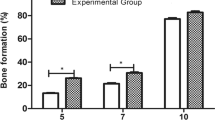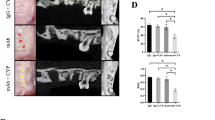Abstract
Objectives
To assess the effect of Tideglusib and CHIR99021 small molecules on the odontogenic differentiation potential of human dental pulp stem cells (hDPSCs) via Wnt/β-catenin pathway activation.
Methodology
hDPSCs were isolated from impacted third molars indicated for extraction and were characterized by flow cytometry. hDPSCs were then induced to differentiate into odontogenic lineage in the presence of Tideglusib and CHIR99021. Odontogenic differentiation was evaluated using Alizarin Red stain and RT-PCR for expression of odontogenic specific differentiation markers: DSPP, DMP1, ALP, OPN, and RUNX2 in relation to undifferentiated cells. RT-PCR was also conducted to assess the expression of Wnt/β-catenin pathway activation marker (AXIN2). One-way ANOVA Kruskal-Wallis test was used for statistical analysis.
Results
Wnt/β-catenin pathway was successfully activated by Tideglusib and CHIR99021 in hDPSCs where AXIN2 was significantly upregulated. Successful odontogenic differentiation was confirmed by Alizarin Red staining of calcified nodules. RT-PCR for odontogenic differentiation markers DSPP, DMP1, and RUNX expression by hDPSCs induced by CHIR99021 was higher than that expressed by hDPSCs induced by Tideglusib, whereas expression of OPN and ALP was higher in Tideglusib-induced cells than in CHIR99021-induced cells.
Conclusions
Both small molecules successfully induced odontogenic differentiation of hDPSCs through Wnt/β-catenin pathway activation.
Clinical relevance
These findings suggest that Tideglusib and CHIR99021 can be applied clinically in pulp regeneration to improve strategies for vital pulp regeneration and to promote dentine repair.





Similar content being viewed by others
Data Availability
The datasets generated during and/or analyzed during the current study are available from the corresponding author on reasonable request.
References
Murray PE, Garcia-Godoy F, Hargreaves KM, Article R (2007) Regenerative endodontics: a review of current status and a call for action. J Endod 33:377–390. https://doi.org/10.1016/j.joen.2006.09.013
Hargreaves KM, Law AS (2010) Regenerative endodontics. In: Cohen’s pathways of the pulp, Tenth Edition, Elsevier, pp 602–619
Zaugg LK, Banu A, Walther AR et al (2020) Translation approach for dentine regeneration using GSK-3 antagonists. J Dent Res 99:544–551. https://doi.org/10.1177/0022034520908593
Birjandi AA, Sharpe P (2021) Wnt signalling in regenerative dentistry. Front Dent Med 2:725468
Birjandi AA, Suzano FR, Sharpe PT (2020) Drug repurposing in dentistry; towards application of small molecules in dentin repair. Int J Mol Sci 21. https://doi.org/10.3390/ijms21176394
Siddiqa A (2020) GSK 3 inhibitors releasing nanoparticles for dentine repair—IJSER Journal Publication. Int J Sci Eng Res 11:1714–1731
Wu D, Pan W (2010) GSK3: a multifaceted kinase in Wnt signaling. Trends Biochem Sci 35:161–168
Neves VCM, Babb R, Chandrasekaran D, Sharpe PT (2017) Promotion of natural tooth repair by small molecule GSK3 antagonists. Sci Rep 7. https://doi.org/10.1038/srep39654
Tatullo M, Makeeva I, Rengo S et al (2019) Small molecule GSK-3 antagonists play a pivotal role in reducing the local inflammatory response, in promoting resident stem cell activation and in improving tissue repairing in regenerative dentistry. Histol Histopathol 34:1195–1203
Sato N, Meijer L, Skaltsounis L et al (2004) Maintenance of pluripotency in human and mouse embryonic stem cells through activation of Wnt signaling by a pharmacological GSK-3-specific inhibitor. Nat Med 10:55–63. https://doi.org/10.1038/nm979
Hanna S, Aly R, Eldeen GN et al (2023) Small molecule GSK-3 inhibitors safely promote the proliferation and viability of human dental pulp stem cells—in vitro. Biomedicines 11. https://doi.org/10.3390/biomedicines11020542
Tolosa E, Litvan I, Höglinger GU et al (2014) A phase 2 trial of the GSK-3 inhibitor tideglusib in progressive supranuclear palsy. Mov Disord 29:470–478. https://doi.org/10.1002/mds.25824
Comeau-Gauthier M, Tarchala M, Luna JLRG et al (2020) Unleashing β-catenin with a new anti-Alzheimer drug for bone tissue regeneration. Injury 51:2449–2459. https://doi.org/10.1016/j.injury.2020.07.035
Ring DB, Johnson KW, Henriksen EJ et al (2003) Selective glycogen synthase kinase 3 inhibitors potentiate insulin activation of glucose transport and utilization in vitro and in vivo. Diabetes 52:588–595. https://doi.org/10.2337/diabetes.52.3.588
Heng BC, Jiang S, Yi B et al (2019) Small molecules enhance neurogenic differentiation of dental-derived adult stem cells. Arch Oral Biol 102:26–38. https://doi.org/10.1016/j.archoralbio.2019.03.024
Govarthanan K, Vidyasekar P, Gupta PK et al (2020) Glycogen synthase kinase 3β inhibitor-CHIR 99021 augments the differentiation potential of mesenchymal stem cells. Cytotherapy 22:91–105. https://doi.org/10.1016/j.jcyt.2019.12.007
Cao N, Liang H, Huang J et al (2013) Highly efficient induction and long-term maintenance of multipotent cardiovascular progenitors from human pluripotent stem cells under defined conditions. Cell Res 23:1119–1132. https://doi.org/10.1038/cr.2013.102
Dang Le Q, Rodprasert W, Kuncorojakti S et al (2022) In vitro generation of transplantable insulin-producing cells from canine adipose-derived mesenchymal stem cells. Sci Reports 12(11):1–18. https://doi.org/10.1038/s41598-022-13114-3
Hoglinger GU, Huppertz H-J, Wagenpfeil S et al (2014) Tideglusib reduces progression of brain atrophy in progressive supranuclear palsy in a randomized trial. Mov Disord 29:479–487. https://doi.org/10.1002/mds.25815
Del Ser T, Steinwachs KC, Gertz HJ et al (2013) Treatment of Alzheimer’s disease with the GSK-3 inhibitor tideglusib: a pilot study. J Alzheimer’s Dis 33:205–215. https://doi.org/10.3233/JAD-2012-120805
Lektemur Alpan A, Çalişir M, Kizildağ A et al (2020) Effects of a glycogen synthase kinase 3 inhibitor tideglusib on bone regeneration with calvarial defects. J Craniofac Surg 31:1477–1482. https://doi.org/10.1097/SCS.0000000000006326
Gronthos S, Mankani M, Brahim J et al (2000) Postnatal human dental pulp stem cells (DPSCs) in vitro and in vivo. Proc Natl Acad Sci USA 97:13625–13630. https://doi.org/10.1073/pnas.240309797
Ahmed NE-MB, Aly RM, El-Massieh PMA, El Azeem AFA (2018) Comparing the stemness properties of dental pulp cells (Dpscs), collected, processed, and cryopreserved under different conditions. J Stem Cells 13:95–106
Huang GTJ, Gronthos S, Shi S (2009) Critical reviews in oral biology & medicine: mesenchymal stem cells derived from dental tissues vs. those from other sources: their biology and role in regenerative medicine. J Dent Res 88:792–806
Shi X, Mao J, Liu Y (2020) Pulp stem cells derived from human permanent and deciduous teeth: biological characteristics and therapeutic applications. Stem Cells Transl Med 9:445–464. https://doi.org/10.1002/SCTM.19-0398
Aly RM, Aglan HA, Eldeen GN, Ahmed HH (2022) Optimization of differentiation protocols of dental tissues stem cells to pancreatic β-cells. BMC Mol Cell Biol 23. https://doi.org/10.1186/s12860-022-00441-6
Ledesma-Martínez E, Mendoza-Núñez VM, Santiago-Osorio E (2015) Mesenchymal stem cells derived from dental pulp: a review. Stem Cells Int 2016:4709572–4709572
Nakashima M, Iohara K (2014) Mobilized dental pulp stem cells for pulp regeneration: initiation of clinical trial. J Endod 40:26–32. https://doi.org/10.1016/j.joen.2014.01.020
Nakashima M, Iohara K, Murakami M et al (2017) Pulp regeneration by transplantation of dental pulp stem cells in pulpitis: a pilot clinical study. Stem Cell Res Ther 43:S82–S86. https://doi.org/10.1186/s13287-017-0506-5
Szubarga A, Kamińska M, Kotlarz W et al (2021) Human stem cells-sources, sourcing and in vitro methods. Med J Cell Biol 9:73–85. https://doi.org/10.2478/acb-2021-0011
Rezai Rad M, Hosseinpour S, Ye Q, Yao S (2021) Dental tissues originated stem cells for tissue regeneration. In: Regenerative approaches in dentistry. Springer International Publishing, pp 9–33
Atari M, Gil-Recio C, Fabregat M et al (2012) Dental pulp of the third molar: a new source of pluripotent-like stem cells. J Cell Sci 125:3343–3356. https://doi.org/10.1242/JCS.096537
El-Moataz N, Ahmed B, Aly RM et al (2018) Comparing the stemness properties of dental pulp cells (DPSCs), collected, processed, and cryopreserved under different conditions. J Stem Cells 13:95–107
Bernkopf DB, Brückner M, Hadjihannas MV, Behrens J (2019) An aggregon in conductin/axin2 regulates Wnt/β-catenin signaling and holds potential for cancer therapy. Nat Commun 10(1):1–14. https://doi.org/10.1038/s41467-019-12203-8
Tziafas D, Kodonas K (2010) Differentiation potential of dental papilla, dental pulp, and apical papilla progenitor cells. J Endod 36:781–789. https://doi.org/10.1016/J.JOEN.2010.02.006
Sabbagh J, Ghassibe-Sabbagh M, Fayyad-Kazan M et al (2020) Differences in osteogenic and odontogenic differentiation potential of DPSCs and SHED. J Dent 101:103413. https://doi.org/10.1016/J.JDENT.2020.103413
Deng P, Huang J, Zhang Q et al (2023) The role of EMILIN-1 in the osteo/odontogenic differentiation of dental pulp stem cells. BMC Oral Health 23. https://doi.org/10.1186/s12903-023-02905-3
Acknowledgements
We acknowledge the help of Dr Adham Abdel Azim in revising the manuscript and providing valuable advice.
Funding
Study was self-funded.
Author information
Authors and Affiliations
Contributions
SH: contributed to the conception of the design, data acquisition, analysis, drafted the manuscript, critically revised the manuscript and giving final approval. RA: contributed to the conception of the design, data acquisition, analysis, or interpretation; critically revised the manuscript; gave final approval. GN: responsible for the molecular studies, critically revised the manuscript, and gave final approval. RP: Contributed to conception or design, analysis, or interpretation; critically revised the manuscript; gave final approval.
Corresponding author
Ethics declarations
Ethics approval and consent to participate
The authors are accountable for all aspects of the work in ensuring that questions related to the accuracy or integrity of any part of the work are appropriately investigated and resolved. All methods were performed in accordance with the guidelines and regulations of the Declaration of Helsinki. Informed consent has been obtained from all participants. The experimental protocol was reviewed by the Ethical Committee of the Medical Research of the National Research Centre, Egypt and granted approval under the number 5435062021.
Competing interests
The authors declare no competing interests.
Additional information
Publisher’s note
Springer Nature remains neutral with regard to jurisdictional claims in published maps and institutional affiliations.
Rights and permissions
Springer Nature or its licensor (e.g. a society or other partner) holds exclusive rights to this article under a publishing agreement with the author(s) or other rightsholder(s); author self-archiving of the accepted manuscript version of this article is solely governed by the terms of such publishing agreement and applicable law.
About this article
Cite this article
Hanna, S., Eldeen, G.N., Alfayate, R.P. et al. The regenerative potential of Tideglusib and CHIR99021 small molecules as potent odontogenic differentiation enhancers of human dental pulp stem cells. Clin Oral Invest 28, 48 (2024). https://doi.org/10.1007/s00784-023-05452-x
Received:
Accepted:
Published:
DOI: https://doi.org/10.1007/s00784-023-05452-x




